Estimated reading time 17 minutes, 7 seconds.
“The biggest thing we are all looking forward to is getting back on the road and interacting with our fans across the country,” said Maj Michelle Curran, lead solo pilot for the U.S. Air Force’s elite Thunderbirds aerial demonstration squadron.
The dramatic impact of the COVID-19 pandemic on public events around the world decimated the airshow season in North America in 2020. Everyone hopes some semblance of normality can return for the summer of 2021, and the eagerly awaited airshow season. Skies caught up with the Air Force Thunderbirds, the U.S. Navy Blue Angels, and the Canadian Forces Snowbirds to find out how they are preparing to get back into the show business.

Like many of us, these display teams have had to adapt to cope with unprecedented circumstances. The 2020 season wasn’t a complete write-off, but many of the flagship events were cancelled or re-purposed as virtual events. In January 2021, Air Combat Command chief, Gen Mark D. Kelly, approved a one-year extension for the 2019-2020 officers to remain with the Thunderbirds to maintain the team’s continuity and operational readiness — after most of team’s public shows were cancelled in 2020 due to COVID.
Looking ahead to the 2021 season, Curran, who is Thunderbird 5, told Skies that the team is “scheduled to perform approximately 50 aerial demonstrations in 26 locations.” But they are “not planning any events or operations outside of the airshows and flyovers approved for 2021.”

COVID has the potential to completely paralyze the health and safety of a close-knit unit, like a display team. Curran explained that the squadron has put a number of “preventative health measures” in place to keep everyone safe and healthy, including routine medical screenings, face masks, social distancing during meetings and operations [to the max extent], and the use of hygiene stations around the squadron. “However, our training season requirements, objectives, and operational tempo remains the same,” she added. “We are hopeful the 2021 show season will bring us back to normalcy where we can get back to school and hospital visits, and meeting our fans in person.”
The Thunderbirds have been engaged in a typical high tempo display work-up training season from their home at Nellis Air Force Base, near Las Vegas, Nevada. The team has made excellent use of social media to help keep its fans abreast of latest activities and developments — including some changes to their demonstration.
“During a normal training season, we are under a time crunch because half of the demo pilots are new to the team and have a rigorous training program to get through,” explained Curran. “This year has been much different with the majority of the team remaining the same as in 2020 . . . [giving] us the time and ability to make some exciting changes to our demonstration.
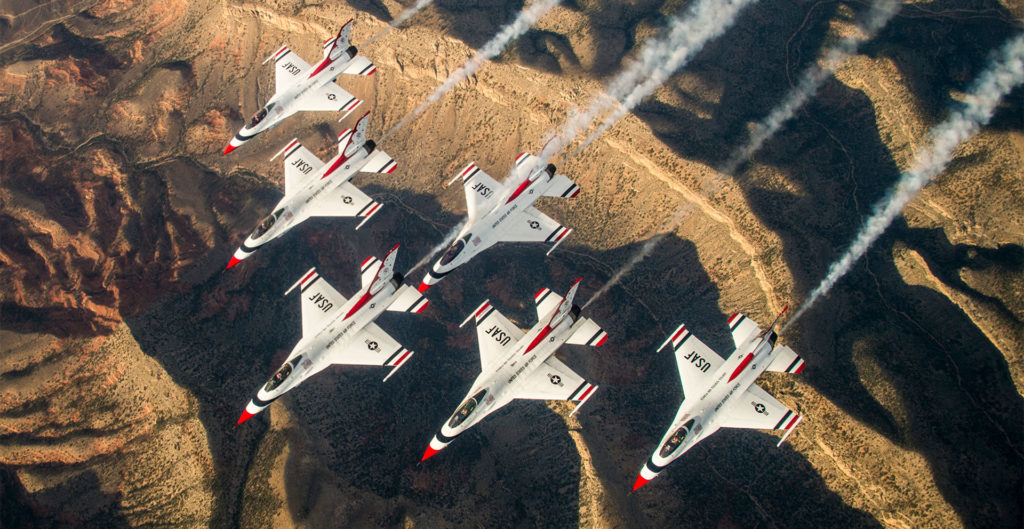
“The only moves we made have been between Thunderbirds 3 and 4,” she continued. “In January, Maj Zane Taylor, 2020 Thunderbird 4/slot pilot, transitioned to be the right wing pilot and will fly the No 3 jet for the 2021 show season. Maj Michael Brewer, 2019-2020 Thunderbird 3/right wing pilot, transitioned to the slot pilot and will fly the No 4 jet for the 2021 show season. This swap between Taylor and Brewer was made to ensure continuity of experience and preserve the team’s future aerial demonstration capabilities and readiness.”
Above all else, as Curran said, the biggest thing the Thunderbirds are looking forward to is getting back on the road and connecting with the fans. “2020 was a very challenging year for everyone, and this season we can bring people back together and showcase our team’s pride and precision,” she said. “Our mission is to recruit, retain, and inspire. We did our best with the ‘America Strong’ city flyovers to continue this mission [in 2020]. Everyone on our team can agree that we can’t wait to get back to the heart of our mission, which is doing airshows!”
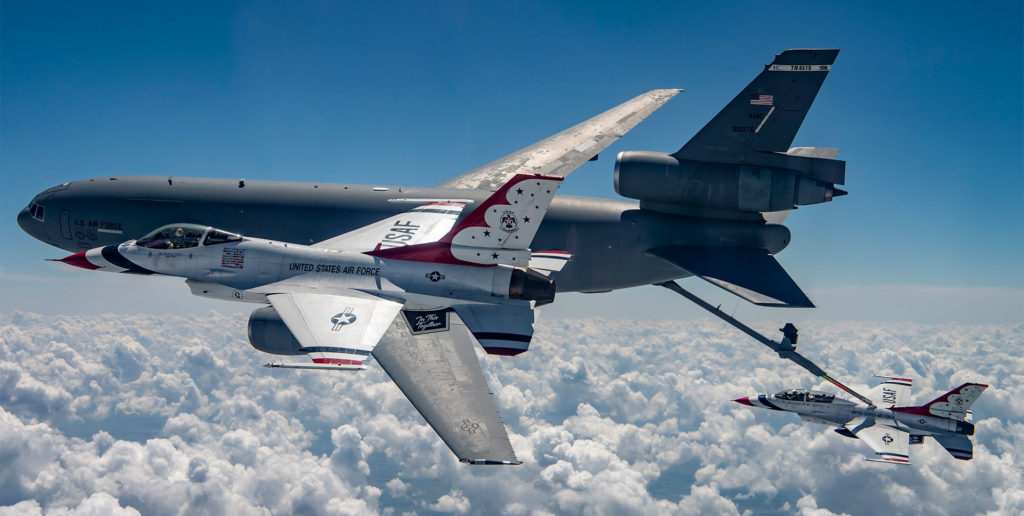
Blue Angels Go Super Hornet
This past February, the Thunderbirds deployed as a squadron to Naval Air Facility El Centro, California, to train alongside the U.S. Navy Flight Demonstration Squadron, the Blue Angels. Although the two teams don’t have any joint events currently scheduled this season, the joint training was conducted as a means to trade best practices and lessons learned in preparation for the forthcoming airshow season. With both teams engaged in their respective pre-season workups, they didn’t fly any full displays. However, they did debut an impressive new joint formation, dubbed the “Super Delta.”
The last time the Blue Angels and Thunderbirds performed together at an airshow was at the Joint Base Andrews Air and Space Expo on May 11 to 12, 2019. Upon cancellation of shows in 2020, the two teams came together in the collaborative, multi-city flyover under “America Strong” — saluting healthcare workers, first responders, military, and other essential personnel serving on the frontlines through the COVID crisis.
This year, COVID isn’t the only major challenge for the Blue Angels; they are transitioning to a brand-new aircraft in the F/A-18E/F Super Hornet. In 2016, the Blue Angels’ higher echelon command established a dedicated Blue Angels Transition Team comprised of former demonstration pilots and maintenance experts. The Transition Team has worked with Naval Aviation Enterprise (NAE) stakeholders to determine the optimum transition roadmap, while also focusing on extensive risk mitigation, airframe fatigue reduction, and the transition training plan. The transition team has spent extensive hours in the flight simulators at Naval Air Station Patuxent River, Maryland, designing the new demonstration elements and maneuver sequences.
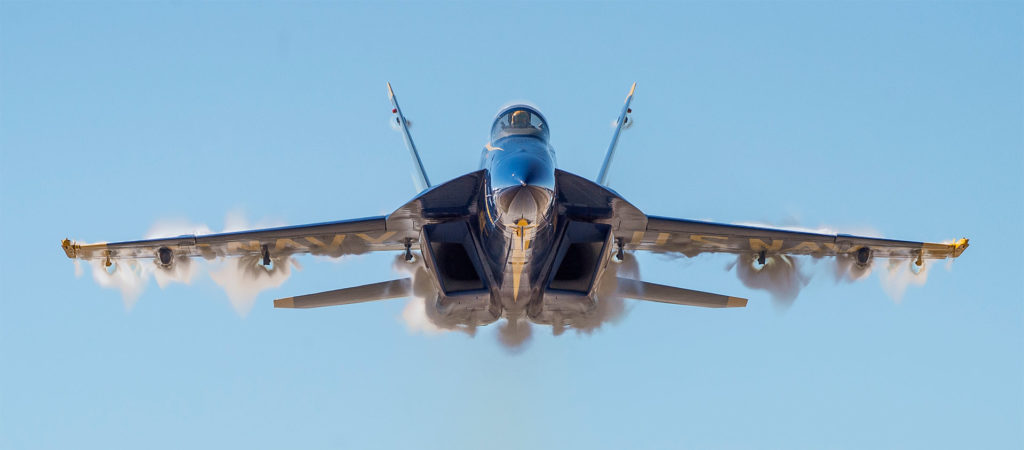
The Blue Angels had flown the F/A-18 Hornet since transitioning from the A-4F Skyhawk in 1986. Transition from the F/A-18C Hornet to the F/A-18E/F Super Hornet was already slated for the 2021 season, so maintaining continuity was an obvious consideration. Like the Thunderbirds, the Blue Angels opted to retain the same pilots for an additional year. However, slight changes were made to the conventional officer rotation — which were pertinent to enable the team to tackle the unique challenges and training requirements of the 75th show season and Super Hornet transition in 2021.
“Shortening the end of the 2020 show season [mid-October vs mid-November] and delaying the start of the 2021 season [mid-April vs mid-March] has allowed time for the pilots and maintainers to train and qualify on the upgraded platform,” explained Lt Chelsea Dietlin, the team’s Public Affairs Officer. “Extra time was allotted for the squadron to complete the standard ‘Safe-For-Flight’ process and inspections that all fleet squadrons undergo. Safety, as always, is the number one priority. The extended training period ensures the team is ready to safely perform an exciting show for the public.”
Ahead of the Blue Angels returning to their home at Naval Air Station Pensacola on March 14, Dietlin told Skies that the team is indeed ready to “execute safe flight operations for the entirety of the 2021 show season.
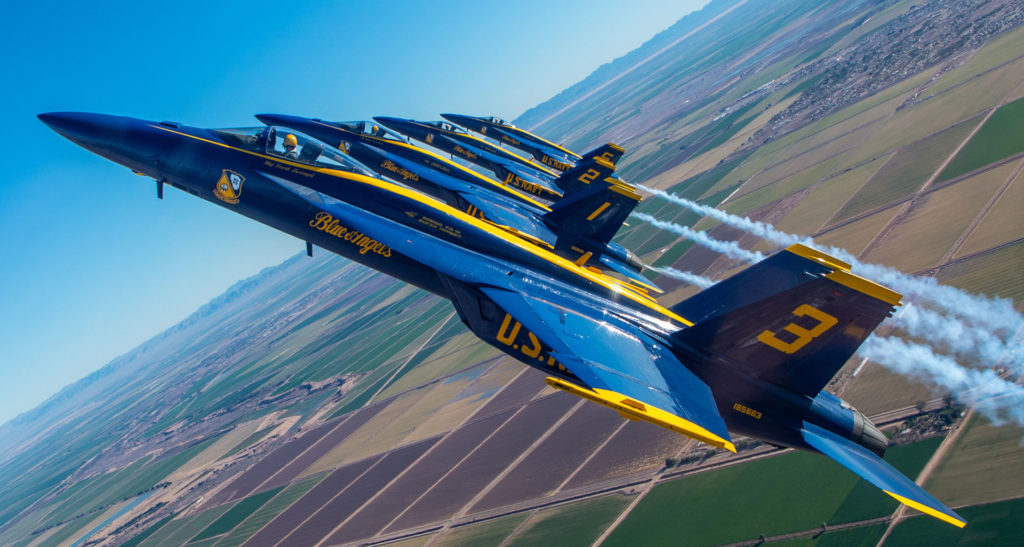
“While the airshows during the 2020 season were cancelled, our pilots and crew maintained a training syllabus of executing five to seven training sorties per week in the community throughout 2020. We look forward to the opportunity to fly for our friends, family, and neighbors across the country and safely re-engage our community outreach mission.”
As the Blue Angels transition to the Super Hornet, the team says most of its signature maneuvers will look very similar — though some will have updates. “The Blue Angels are excited to unveil the Super Hornet demonstration to the public during the 2021 airshow season,” said Dietlin. “The main difference between the platforms is the size and handling characteristics of the aircraft. The Super [Hornet] is roughly 33 percent larger, which means larger control surfaces creating a slight change in maneuverability of the aircraft. The roll rate of the Super Hornet is marginally less than the Hornet.
“Additionally, slow speed handling in the Super Hornet is improved, making for even slower airspeeds in aerobatic maneuvers such as loops, rolls, and passes. The Super Hornets also include upgraded avionics software allowing for smoother in-flight communications.”
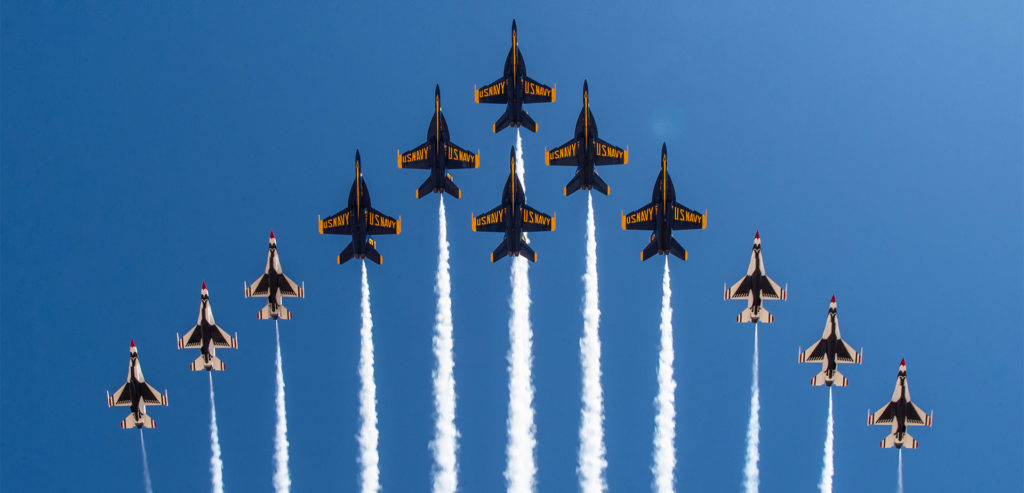
The Super Hornets were drawn from in-service examples with fleet units. The aircraft have received a number of Blue Angels-specific modifications, including a control stick with a spring that forces the pilot to constantly exert pressure — even in level flight. This assists with smooth formation flying. The M61A2 20mm Gatling gun in the nose has been removed and replaced with a smoke system. The landing gear has been altered to let the pilots fly with gear extended at faster-than-usual air speeds of up to 300 knots, and with more G loading. An inverted fuel system has been added so the jets can fly upside-down for longer periods than stock Super Hornets. And the aircraft’s avionics software has been modified to customize the information shown to the pilot on the cockpit displays.
Since the team often takes VIPs and media personnel for rides, the classified information found on the cockpit displays has been removed. The navigation equipment on the aircraft is also being modified since the team spends much of their time flying to and from civilian airports.
“While similar, the aircrew and maintenance qualifications are unique to the F/A-18E/F Super Hornet, and require additional training for all Blue Angels,” explained Dietlin, drawing comparisons with the “Classic” Hornet. The changes mirror the differences in operating the original Hornet variant and the Super Hornet in fleet squadrons.
“For those team members previously qualified on the F/A-18E/F Super Hornet or EA-18G Growler, the refresher training has been a straightforward process commonly executed throughout the fleet,” added Dietlin. “While these jets have been flown in the Navy for 20-plus years, they have only been flown in a Blue Angels configuration for a few months. Winter training has been critical in learning the needs of the pilots, demonstration aircraft, maintenance, and supply.”
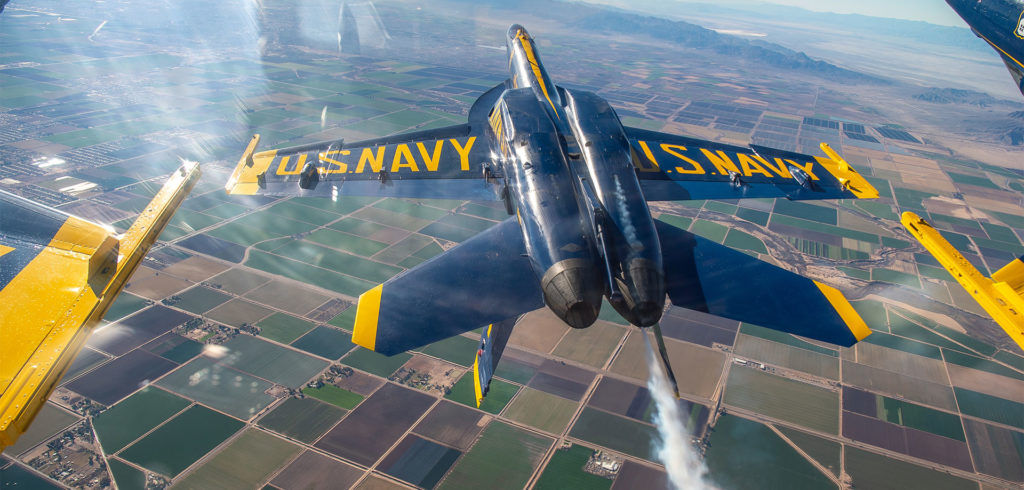
The team says numerous measures were put in place to maintain the health and strength of the team, such as physical distancing, teleworking to the maximum extent, the use of face masks in workspaces, and increased cleaning routines.
Having deployed from the team’s home at NAS Pensacola, Florida, for winter training, Dietlin emphasized the importance of being able to use the great weather and facilities in southern California. “El Centro is our second home, and we are thankful to have had such strong support from the base and the community for over 50 years. Our time in El Centro is crucial for transitioning in new pilots, training support and maintenance personnel, and preparing the aircraft for the high operating tempo of the airshow season.”
Looking ahead to the forthcoming season, Dietlin said safety remains as the “number one priority. While each practice and situation are different, I can tell you that the Blue Angels undergo intensive and rigorous training to identify and mitigate safety challenges. As the team conducts its first season on the new Super Hornet platform, we continue to take incredible measures to ensure that every airshow will be a positive and safe experience, showcasing the great things our Navy and Marine Corps are doing around the world.”
Snowbirds Back in Business
Meanwhile, the Royal Canadian Air Force’s Snowbirds demonstration squadron is also gearing up for what is hoped to be a successful 2021 season in a very special year. “Like everyone else, we want everything to go back to ‘normal,’” team leader Maj Jean-François Dupont, Snowbird 1, told Skies. “Despite seeing the light at the end of the tunnel, we know there is still a long road ahead. Therefore, we want to use our skill, professionalism, and teamwork to bring positivity and hope to as many people as we can doing what we do best.

“We are also very proud to celebrate our 50th season, which is a significant milestone for our team,” Dupont continued. “Our pre-season training has been going very well, and we are on track to be more than ready for our 50th season. We’ve been building the show up gradually as we do every year, and recently flew our first nine-plane practice flight with the 2021 show team.”
Of course, COVID has made planning a lot more difficult, “so we’ve been working closely with airshow organizers to support them in this new, challenging environment. We are striving to adapt and be more flexible in order to reach our audiences safely during our 50th season.”

In May 2020, the team experienced a very sad and unfortunate accident that resulted in the tragic death of Capt Jennifer Casey, who was public affairs officer at the time. “After the accident, we took an honest and fresh look at everything we have been doing,” said current Snowbirds Public Affairs Officer, Lt Becky Major. “We made some changes to our training and how we operate to enable a safe return to flying operations. We have the utmost confidence in our team who maintain and fly” the Snowbirds’ CT-114 Tutor aircraft.
Akin to the Thunderbirds and Blue Angels, since the Snowbirds were unable to complete a full show season in 2020, pilots who were new to the team last year remain the new pilots for 2021. They are Capt Arpit Mahajan (previously a coordinator), Capt Patrice Powis-Clement, Capt Steven Sparks, and Capt Erik Temple (the new coordinator).
Speaking about the 2021 work-up, Dupont said, “Despite half of the formation being experienced Snowbirds pilots, we always go back to the beginning and build up from there. We start with smaller formations and easier maneuvers and gradually increase the difficulty until we are able to put together our full demonstration. Then we keep practicing to ensure we present the best air display possible throughout the show season.”
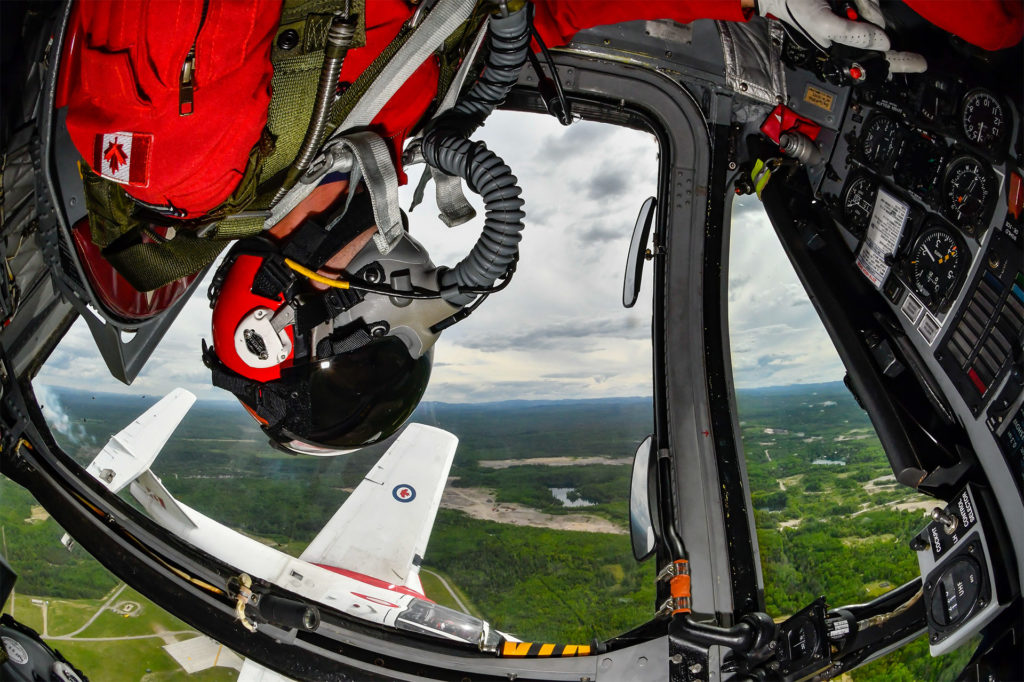
With a 50th anniversary season for the Snowbirds, and new jets for the Blue Angels, 2021 is set up nicely as a significant year for North America’s premiere airshow acts. While a number of shows have already been cancelled due to COVID, new protocols and safety measures — plus a successful immunization process — will hopefully enable many of us to enjoy airshows once again, and begin the slow return to normality. If and when that’s possible, there’s a lot to look forward to from the dedicated men and women of the world’s greatest air display teams. Bring on the noise!

